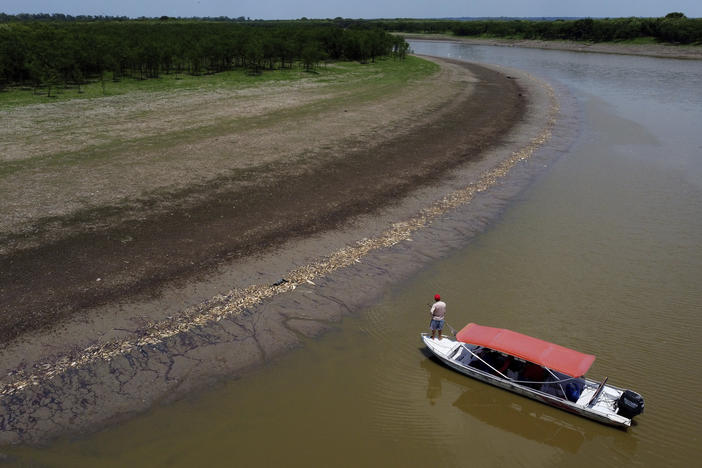Section Branding
Header Content
Humans and dolphins work together to fish in southern Brazilian city, ecologist says
Primary Content
NPR's Ari Shapiro talks with Mauricio Cantor, behavioral ecologist at Oregon State University, about his study on how humans and dolphins work together to fish in a southern Brazilian city.
Transcript
ARI SHAPIRO, HOST:
Our next story takes us to the coastal town of Laguna in southern Brazil, where bottlenose dolphins hunt for prey.
(SOUNDBITE OF DOLPHIN CLICKING)
SHAPIRO: That's the sound of them zeroing in on a school of fish. What's unique about this place is that as the dolphins herd fish around the local lagoons, people hurl their nets at the same time. It's an example of cross-species collaboration that turns out to be beneficial to both. Mauricio Cantor of Oregon State University is lead author on a new study about that relationship. It's out this week in the Proceedings of the National Academy of Sciences. Welcome to ALL THINGS CONSIDERED.
MAURICIO CANTOR: Thank you very much. Thanks for having me here. It's a pleasure.
SHAPIRO: You've watched this cross-species collaboration take place. Paint a picture of it. What does it look like?
CANTOR: Yes, so this interaction takes place in the canal of a lagoon that connects the lagoon to the ocean in Laguna southern Brazil. And if you go there every day, you will see many artisanal fishers waiting for the moment that the dolphins approach the coast.
SHAPIRO: So it's up to the dolphins. The dolphins decide when it's going to happen.
CANTOR: Not all of them. Some of the dolphins in the population, what the locals call is a good dolphin, the cooperative dolphins.
SHAPIRO: (Laughter).
CANTOR: Yeah. So when a good dolphin approach, everybody will run into the water and get ready for the interaction. So they will stay in the water, with the water more or less up to their chest, and wait for a specific behavior cue that the dolphins do, a sudden, deep dive that they do in front of the fishers. And they will interpret that as the right time and place to cast their nets.
SHAPIRO: This cooperative relationship has been going on for more than a century. And your study quantified the benefits to humans and dolphins. You found the people netted many more fish as a result. But what's in it for the dolphins?
CANTOR: So the hypothesis is that they are also catching more fish, like the humans are doing. But this is really tricky to measure because, again, the water is very murky. You cannot just put a camera and see what's going on underwater. So what we did was combining a couple of tools - drones, underwater microphones and a sonar camera that uses sounds to generate images, much like an ultrasound for pregnancy tests. All of our evidence suggest that the dolphins only go after the fish when the fishers do their part in the right time. For example, casting that nets in the right time and place, that makes it much easier for the dolphin to catch the fish.
SHAPIRO: How unusual is it to find an example of human-animal collaboration, where both species benefit?
CANTOR: These human-wildlife cooperation, they're a rare phenomena on a global scale. There is a couple of cases in Myanmar and India and others that have been extinct (ph) already, for example, in the eastern coast of Australia and in other places, like the northwest of African continent. So it's a rare phenomena. And our data over the past 15 years have been suggesting that it's becoming rarer in that place in Laguna as well.
SHAPIRO: Is there a significance to these findings, beyond a lagoon in southern Brazil?
CANTOR: Yes. The way I like to see this, and I think it's a good example of how humans and wildlife and humans and nature in general can benefit in a mutually positive way. So most of the interactions that we have with nature tends to be negative, from one side. You can see, like, overfishing, overhunting, you know, degredation of the habitat being at pollution and the list goes on. So trying to preserve a cultural practice that is beneficial for both parties, I think, is inspiring. And by preserving cultural diversity, we can indirectly preserve biological diversity.
SHAPIRO: Mauricio Cantor is a behavioral ecologist at Oregon State University. Thank you very much.
CANTOR: Thank you. Thanks for having me.
(SOUNDBITE OF MUSIC) Transcript provided by NPR, Copyright NPR.
Bottom Content



